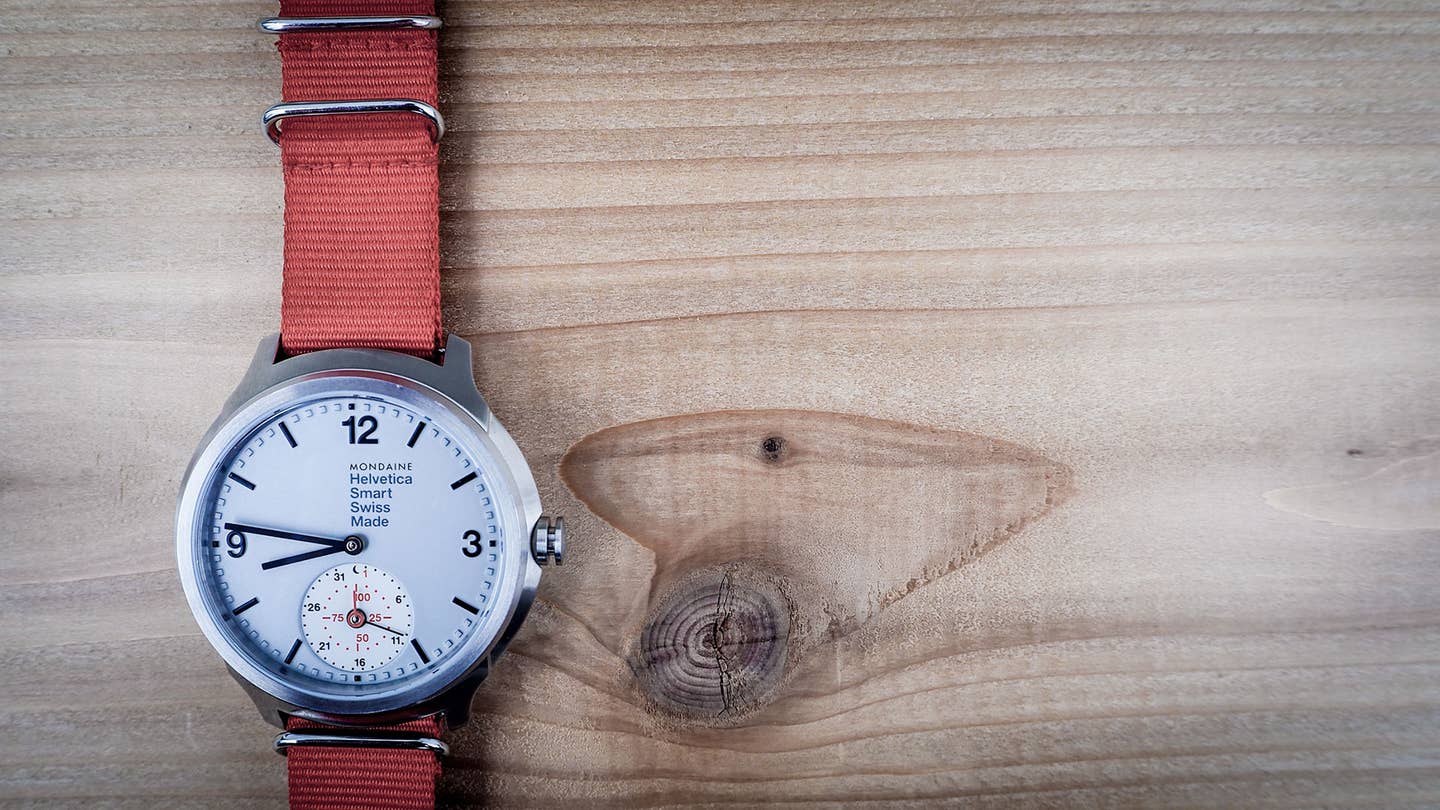This Classic Mondaine Watch Hides a High-Tech Heart
The Helvetica No.1 Smartwatch is new, yet Timeless.

We may earn revenue from the products available on this page and participate in affiliate programs. Learn more ›
At the top of a mountain in Norway, after climbing for over an hour, I looked at my wrist and saw my activity level for the day. Not on a glowing display, but rather on a small orange indicator within the white sub-dial of the new $950 Mondaine Helvetica No. 1 Smartwatch. The timepiece looks…well, it looks like a watch. Only the wearer knows how much tech he's actually packing on his wrist; invisible to the casual observer is the fact that the Mondaine tracks daily steps, mileage walked and run, calories burned, and measures the quality of your sleep and can periodically alert the wearer to get moving if he's been sedentary too long.
What everyone does see is a handsome stainless steel timepiece with a 44mm case diameter that’s beefy enough to withstand your daily gym grind or a 100-foot ocean dive but refined enough to wear to the office, or even under a cuff-linked sleeve. The watch is also a mini history lesson, if you know what to look for.
Mondaine’s iconic Swiss Railway watches don’t have numerals, just hour markers. They’re a nod to the Official Swiss Railway Clocks that began to appear in 1944 and are now found in stations throughout the mountainous nation. The Railway wristwatches didn’t debut until the 1980s, but are today considered classics. Somehow the same can already be said for Mondaine’s Helvetica series, which began only a couple years ago, in 2014, because they meld the Railway aesthetic with the famous Swiss typeface originating in 1957. Helvetica is the Latin name for Switzerland; the country's "CH" abbreviation stands for Confoederatio Helvetica.
The “smart” version of the watch truly is just that. Its tracking guts are sourced from Silicon Valley’s Fullpower, which supplies motion tracking and data analytics to companies like Apple and Nike. They’re the brains behind the Swiss Horological Smartwatch consortium that includes not only Mondaine but Movado and Frederique Constant, with the theory that smart capabilities are desirable—but so is classic Swiss watch design.
Pairing the Mondaine model with the MotionX app on my iOS phone (it also works on Android) allowed me not only to eyeball daily activity, but set a wake-up alarm and also to have that alarm time “float”—meaning, the watch sensed when I was coming out of deep sleep and beeped at a more natural time rather than startle me out of a dream state. Yes, it works, and yes, you do feel fresher as a result.
I could also set a second time zone I wanted to keep tabs on while traveling (tap the crown three times and the hands of the timepiece rotate to that other time zone for a few seconds, then rotate back to your present zone). You can also change step goals within the app, and you can share all the captured sensor data to Apple’s Health App just like with an Apple Watch.
Ultimately, it isn’t quite as accurate as the Apple Watch. Mileage counts from my runs were off a few tenths of a mile over the course of five miles (the Apple Watch is spooky good at nailing mileage totals), and daily calorie burn was likely over-optimistic as well—the Apple Watch uses your heart rate in addition to motion to get that calculation, while the Mondaine has no heart rate sensor.
Still, the Mondaine Helvetica No. 1 never needs charging, with its two-year battery life, and is an awesome alternative for people who will never strap a digital device to their wrists. My main knock: The leather band is a bit too upscale to work in sweaty as well as pedestrian circumstances, so I swapped to a Nato band instead, which just happens to make the Mondaine look, yes, smarter.
